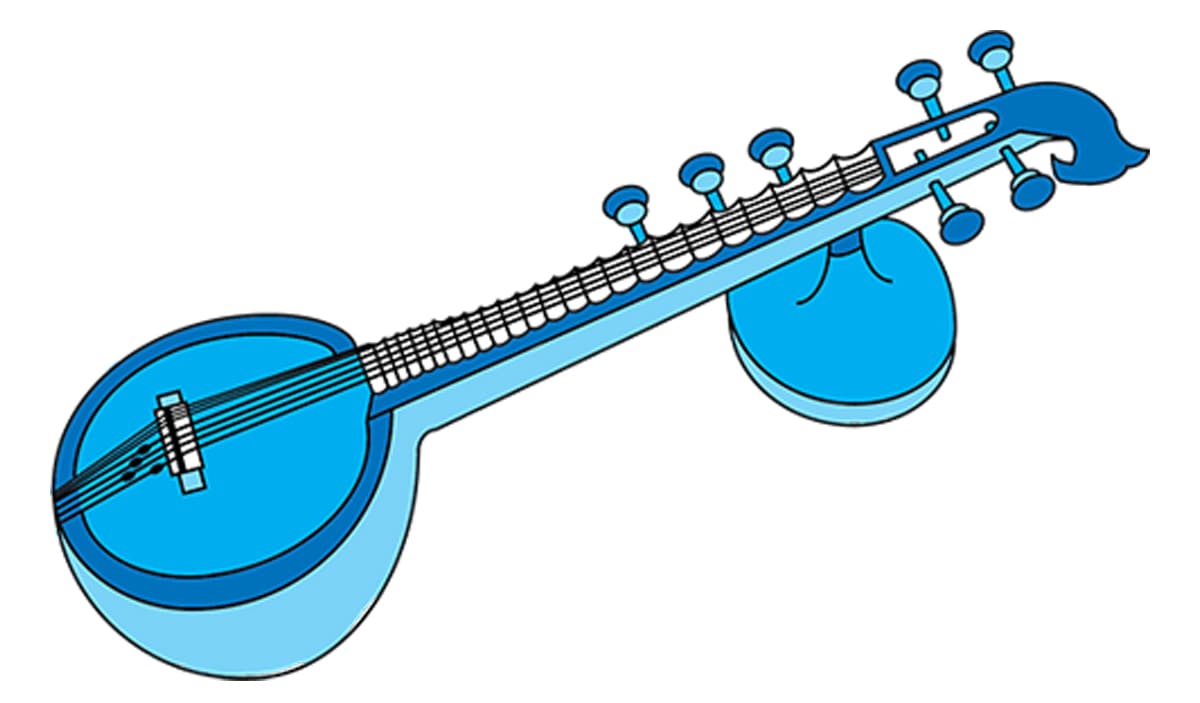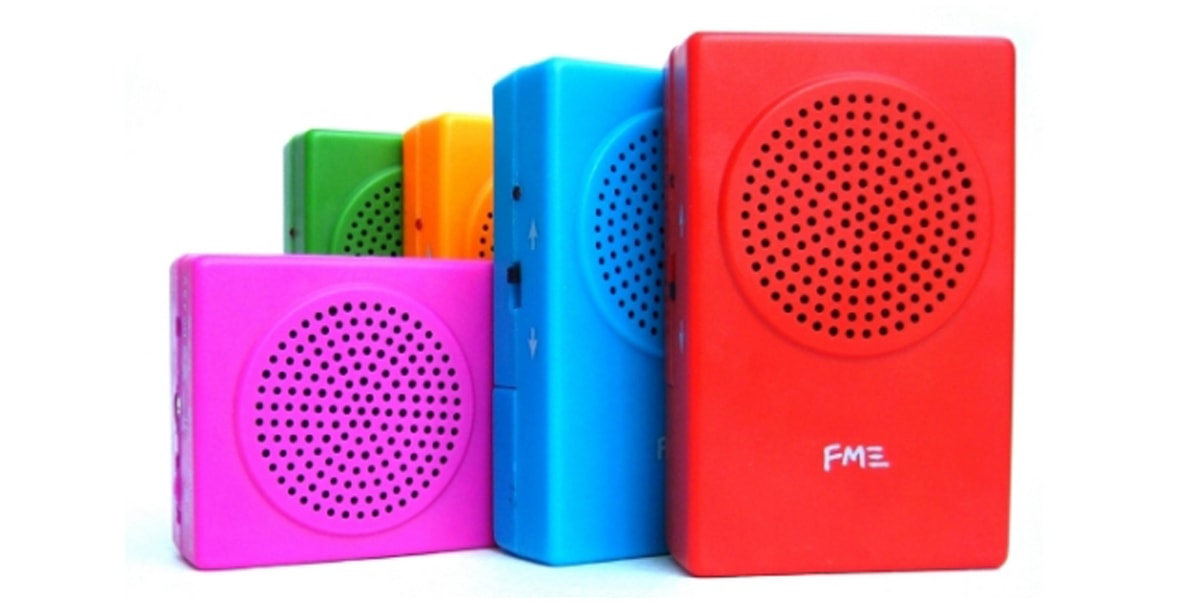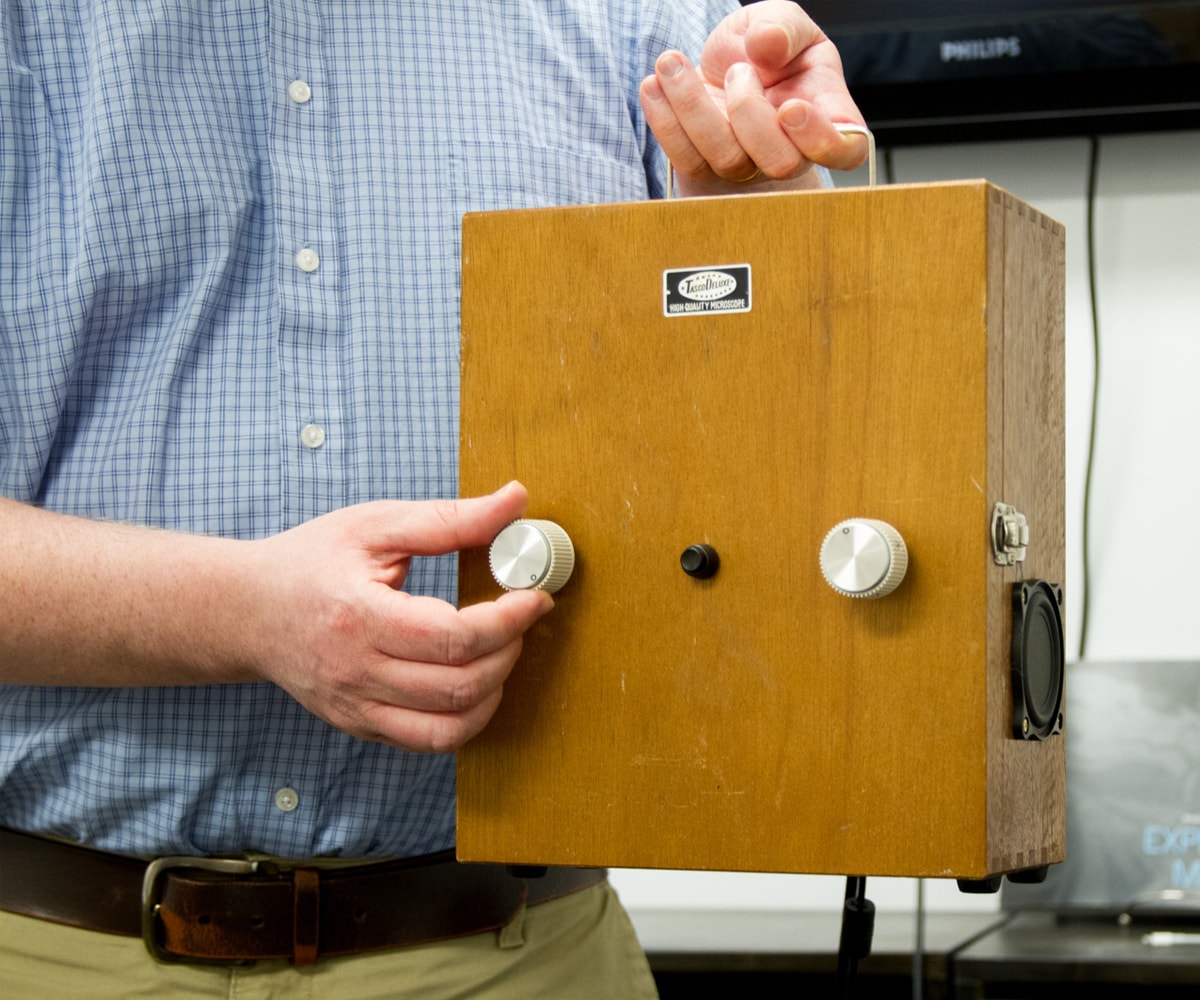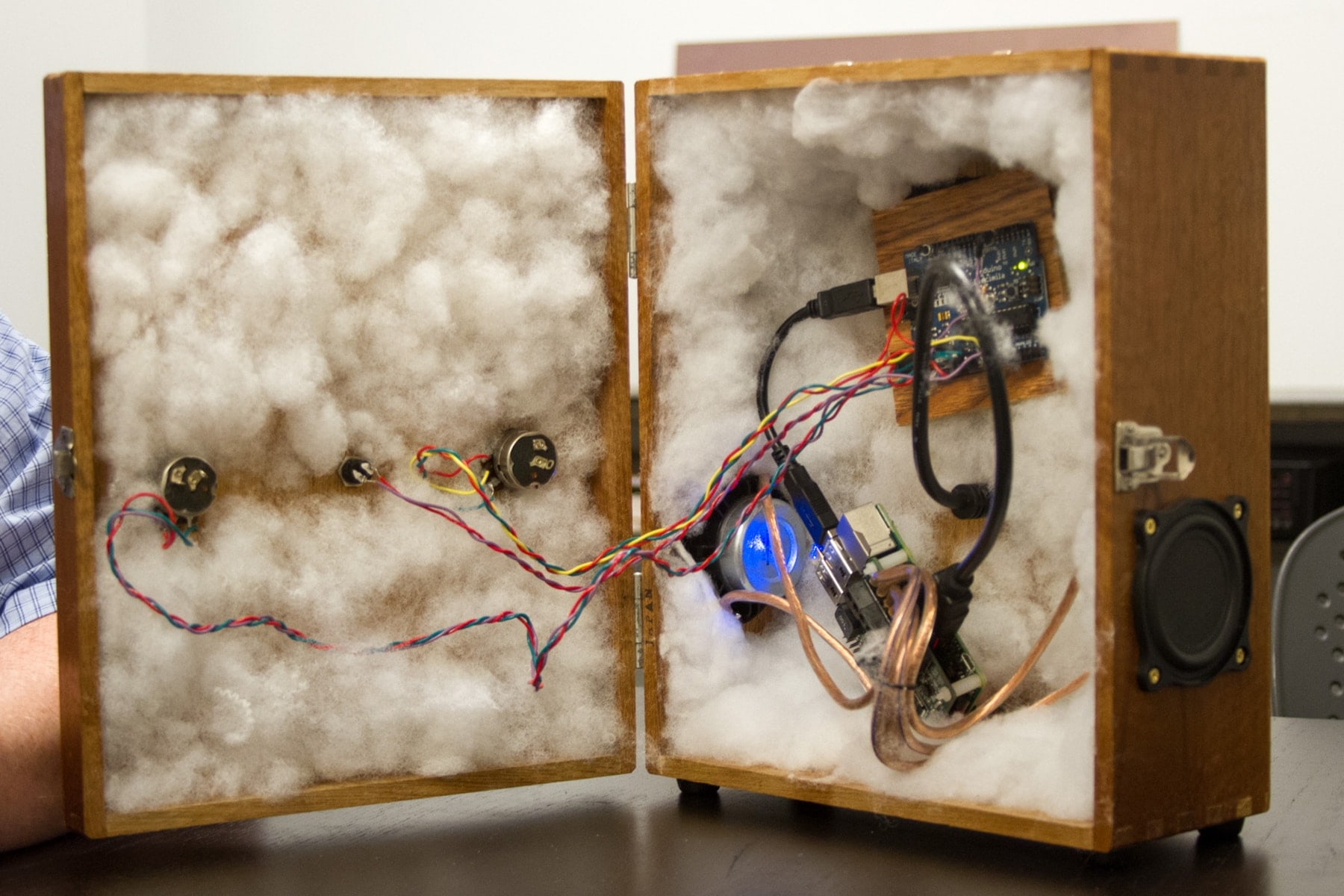Last January, assistant professor of music and sound design Dr. Greg Dixon traveled to Liverpool to present his innovative compositions — and the instrument he built to play them — at a concert on behalf of the Instruments India Composition Commission.
In 2015, Milapfest, an England-based Indian arts organization, and Liverpool Hope University (LHU) put out a call asking for composers to write and submit music using Milapfest-LHU’s newly compiled archive of Indian instrument sounds. Winning proposals would need to incorporate the sounds of dozens of classical Indian instruments — such as the mandolin, veena, or udukkai — in new and interesting ways. When he first heard about the project, Dixon says, he knew he had to participate.

“I sent in this proposal that said I would, if selected, build a new instrument that would be able to play back sound loops, and that I would make a series of sound loops for this new instrument to play back,” says Dixon. “I specified a ‘computer-embedded instrument,’ so this instrument has a computer inside of it that’s essentially driving the whole thing.”
His pitch caught the commission’s interest, and in October 2015 Milapfest-LHU chose Dixon and three other composers from around the world to take part in the Instruments India Composition Commission.
As a veteran sound designer with over 15 years of sound engineering experience and a Ph.D. in music composition with a specialization in computer music, Dixon is no stranger to writing works using unfamiliar sounds. With this grant project, he wanted to expand his knowledge by building a new electronic instrument, but he also wanted to push his limits compositionally. So rather than submit a proposal for a traditional set of song tracks, Dixon proposed using the instrument samples to create tracks that repeated seamlessly and had no beginning or end — in a word, loops.
Looping Inspirations
Dixon first became fascinated with loops after he started teaching at DigiPen in the fall of 2014. Before that, he says, he hadn’t really been exposed to the kind of loops composers write for interactive electronic media such as video games. “Even though I had had years and years of sound design doing other electronic music production, I hadn’t done games,” he says. “So, through working at DigiPen, I became very fascinated with loops.”

So what exactly is a loop? For video game enthusiasts, the most common form of loop is probably the background music in action and adventure games, which may or may not have a discernible beginning and ending and may change as the player progresses through different environments. Other common forms of loops include short audio tracks on “white noise” smartphone apps and digitally produced drum beats in popular music. In all cases, but especially with video games, looping music tracks are composed to augment an experience but not interfere with it.
“With games, it’s not just that we’re using loops because we don’t know how long a player is going to be in a particular area or level with the music,” Dixon explains. “There’s an added benefit that not many people talk about but that I’m fascinated by, and it’s the idea that loops actually aid in the concentration of the player.” He points out that while it’s nice to have a “good” soundtrack in a video game, it’s even better to have “a soundtrack that actually helps the player become better at the game.”
In a way, I think I’m trying to help musicians outside of video game audio have a little bit more of a respect and a reverence for the art of looping.”
The concept of sound-aided concentration also appears in Indian spiritualism, which Dixon learned as he researched Indian music and instruments. “What I started to realize,” he says, “is that mantras and prayers and these types of things are used, in general, to aid in meditation. And there are studies that have shown repetitive and mantra-like behaviors can actually guide in concentration.”
“This idea really fascinated me,” he says. “If we repeat something again and again, and if we have a mantra we repeat, then over time we can build concentration.”

Dixon composed a set of 12 loops, each with its own title. He calls the entire set “Anantatā (Navajīvana),” a Hindi title that roughly translates to the paradoxical phrase “infinity (regenerated)” in English. This paradox is precisely what Dixon hopes to capture — the abstract notion that a loop can exist, simultaneously, as both an entity that occupies a single moment as well as a never-ending pattern with the potential to play infinitely.
“For composers, it’s actually really hard to write loops,” Dixon says, “because you want to write something that you can listen to a hundred times yet still be into.” Simply put, Dixon asks, how do you compose for the infinite? The answer to this question — if there is an answer — may lie in the unusual instrument Dixon devised to play his loops.
The Space Regenerator
As he delved deeper into the world of Indian music composition and looping theory, Dixon discovered a variety of instruments and devices Indians had long used to aid in meditation practices. In particular, Dixon drew inspiration from what he calls “prayer machines” — electronic sound machines that loop a variety of monotonous tones, or drones — and specifically the Buddha Machine, a loop player invented by the Chinese experimental music duo FM3 in 2005 that features a wheel to control the pitch of the audio output. Each of the Buddha Machine’s nine drones are less than a minute long, Dixon says, and “tends to be rather ambient and meditative.” By turning the wheel on the Buddha Machine, the listener can alter the sound of the selected drone dramatically, transforming it from a pulsating hum to a high-pitched squeal.

Drawing from his research, Dixon designed and built his own loop player, which, like the Buddha Machine, features a button to change tracks and a dial that changes the pitch of the selected track. He calls his device the Space Regenerator.

The journey to create the Space Regenerator wasn’t quick or easy, Dixon says. He estimates his total time spent on the project at upwards of 200 hours. Regarding the process, he says, “It’s not like what people would normally think composers do. It’s more of like what inventors do.”
To construct his loop player, Dixon collected a variety of hardware, including an Arduino microcontroller, a stereo speaker system, a potentiometer, a switch, and a Raspberry Pi 2 computer with a digital-to-analog converting shield on top. To house the electronics, he used an old microscope case, which his wife had found free on a community reuse/recycle website. (“The microscope was kind of messed up, so we ended up getting rid of that,” he recalls, “but I said, ‘No no no, don’t do anything with the box!’”)
Dixon’s invention (which he considers a prototype) is about the size of a shoebox, and plugs into a monitor display via HDMI cable. The internal components are fairly simple, Dixon says. “What the microcontroller does is essentially measure resistance and different functionality from the controls and then communicate with the computer system to manipulate the audio in the program,” he explains.
To demonstrate the device, Dixon clicks the switch in the center of the box to turn it on, and it instantly starts to emit an effervescent rhythm of bubbles and chirps (the sounds of several Indian instruments, including the udukkai, ghatam, and morsing). “So right now, this is your volume,” he says, twisting one of the knobs. “And this is playback speed,” he says, twisting the other knob. The drone grows in loudness and speed accordingly, transforming the bubbling and chirping sounds into high-pitched gurgles and whistles.
To the unacquainted, the Space Regenerator does not seem to do much more than change the volume and pitch of whatever music is plugged into it. Dixon does not dispute this observation, but notes that the purpose of the device is not practical, but artistic.
“Honestly, a lot of people would look at this — and I actually know, because I’ve talked to people — and they think it’s just kind of crazy and dumb and esoteric, because everybody thinks of music as something on their phone,” Dixon says. One of the big differences between the Space Regenerator and your smartphone, he says, is that the Space Regenerator can, right out of the box, “play music better than your phone.”
“It is the only ‘prayer machine’ design that I know of that projects stereo sound in high fidelity and that also runs on an embedded computer, giving it a much larger memory capacity for playing back digital audio files,” says Dixon. “These features make it ‘better’ than other prayer machine designs and the higher fidelity makes the sound projection ‘better’ than a smartphone.”
Dixon never intended for the Space Regenerator to be a potential product that consumers would want to buy. His primary objective, he says, has always been to shed light on the beauty of music loops. “When you go outside of games and into academia, many people don’t really look at loops as being a relevant, beautiful form,” he says. “Many people in academic circles wouldn’t think of video game music as being artistic. So I think, with this, I’m trying to translate some of the idioms from video games — or some of the technology from video games — into a different realm. … In a way, I think I’m trying to help musicians outside of video game audio have a little bit more of a respect and a reverence for the art of looping.”
Performing for the Infinite
On January 20, 2017, in the Capstone Theatre at Liverpool Hope University, Dixon unveiled his completed Space Regenerator and “Anantatā (Navajīvana)” to the organizers of the Milapfest-LHU partnership and an audience of concertgoers.
Dixon showed the Space Regenerator in several formats, including a standalone exhibit where attendees could play with the Space Regenerator, as well as what Dixon calls the “Space Regenerator Commander,” a paired-down second version of the Space Regenerator that lacks the embedded computer and internal sound generation. Dixon used this latter version of his invention to perform live at the concert in the Capstone Theatre, making use of the venue’s 8.2 multi-channel surround sound. During the performance, he invited members of the audience to come up and experiment with the instrument.
With his debut over, Dixon is looking toward the future of the Space Regenerator, including new ways to introduce more people to the concept of using loops to aid in concentration. He plans on working with DigiPen math professor Dr. Matt Klassen — who helped Dixon with the audio programming — over the summer to create an iPhone version of the Space Regenerator. “I love the idea of getting a user community together so that people can just compose loops and put them into [the Space Regenerator app],” Dixon says. He’ll also be using his research to create an embedded sound installation as part of a joint project with art professor Peter Moehrle. As if all that isn’t enough, Dixon is already working on another version of the Space Regenerator Commander for Milapfest-LHU, so they can use the instrument and play his loops at any time.
“Emotionally, it was really amazing to complete this commission,” says Dixon. “I felt really refreshed after completing things and I’m ready to move on in new directions for a period of time, but I would like to come back to my research and make some more improvements and perhaps more instruments.”
Watch Dixon demonstrate how to use the Space Regenerator Commander in the video below.